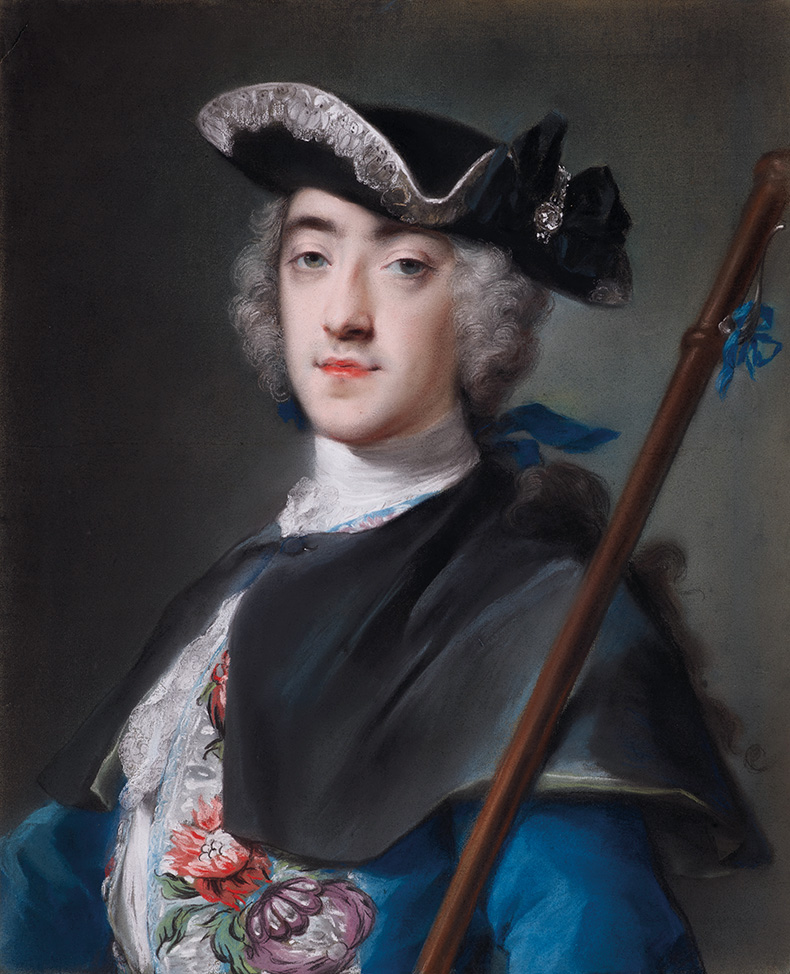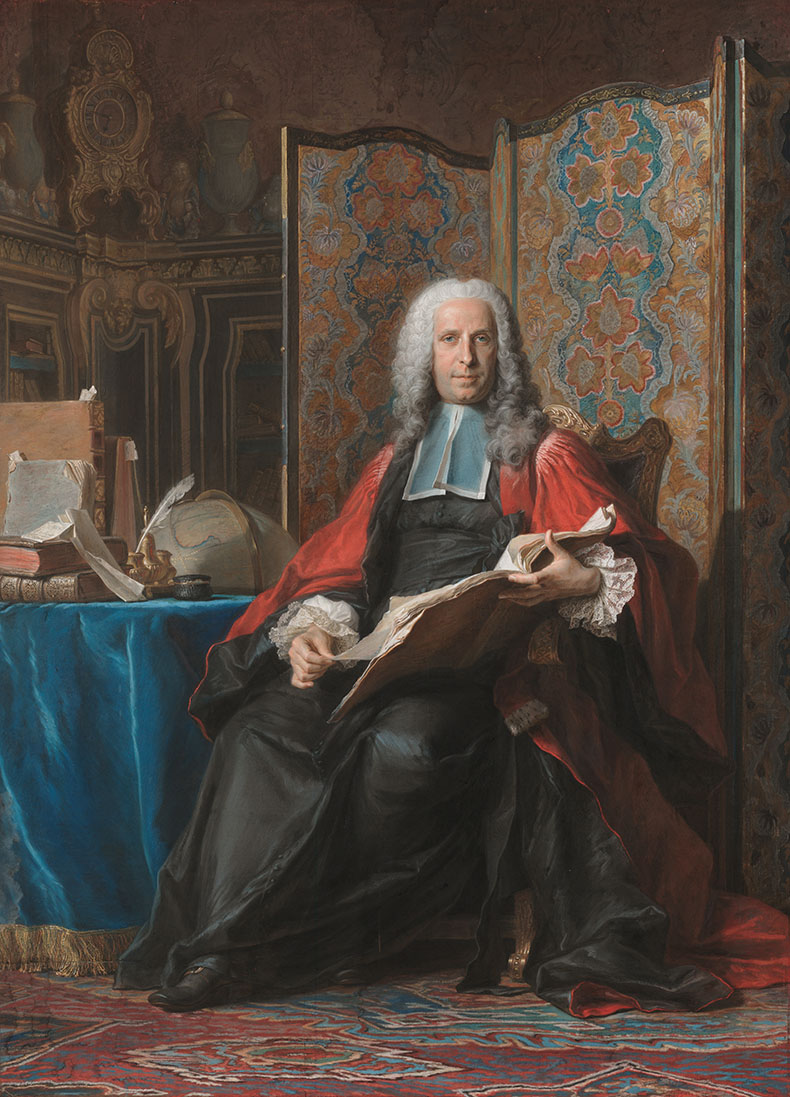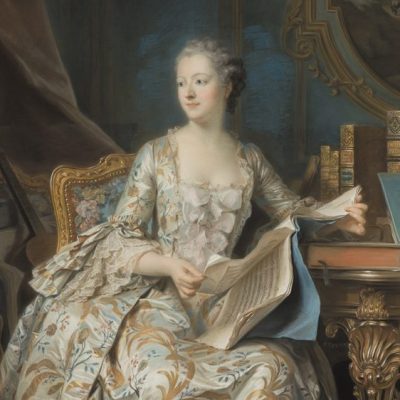This review of A Delicate Matter: Art, Fragility, and Consumption in Eighteenth-Century France by Oliver Wunsch (Penn State University Press) appears in the September 2024 issue of Apollo. Preview and subscribe here.
A small piece of paper is tucked into the strainer of a portrait by Rosalba Carriera: a tightly folded devotional representation of the Three Magi. ‘Gaspar, Melchior, et Baldassar’ were believed to protect travellers during long journeys. Appropriately, the unidentified sitter is wearing the costume of a traveller – a pilgrim – over his embroidered floral jacket, though this is probably a specific allusion to the Carnival that drew Grand Tourists to Venice in the 18th century, the probable time and place of the portrait’s creation. Since the 1730s, Carriera’s pilgrim has travelled further than either its creator or commissioner can have imagined. In 2020, it entered the collection of the Frick. Yet Carriera’s piece of paper has apparently done its job: though the name and circumstances of the sitter have been lost, his effervescent portrait remains intact.
Portrait of a Man in Pilgrim’s Costume (c. 1730), Rosalba Carriera. Frick Collection, New York. Photo: Joseph Coscia Jr

Coming away from the discussions of 18th-century art practice in A Delicate Matter by Oliver Wunsch, the reader may wonder how any artworks from this period have survived at all. Pastel, the medium Carriera helped pioneer, comprises little more than a cloud of dust loosely adhering to a support. Recent research now suggests that even minor tremors cause ‘material fatigue’ to the surface that remains invisible, ‘until the cumulative effect passes a threshold, resulting in sudden and catastrophic damage’. However, Wunsch’s study suggests that the delicacy of 18th-century pastel was nothing out of the ordinary. Works in all kinds of media were fragile. In addition to a chapter on Carriera and Maurice-Quentin de La Tour, another leading pastelist of the period, Wunsch’s book addresses the technically slapdash paintings of Jean-Antoine Watteau in the 1710s, the vogue for ‘imperishable’ paintings in the 1750s, and the terracotta sculptures of Clodion. He also takes in a discussion of the craze for ballooning which briefly seized Paris at the end of the century and encapsulates many of the book’s main concerns: the delicate, the temporary, and the need to negotiate newly dominant market forces.
Central to Wunsch’s remarkably tight-focused book is the suggestion that the perishability of art, long seen by art historians as little more than an impediment to research, is a subject of interest in itself; a feature, rather than a bug. After the death of Louis XIV in 1715, he argues, the ‘posterity-minded’ model of royal and state patronage began to decline. Art could no longer exist outside the short-termism of the market. Carriera was a friend of the Scottish banker John Law, whose ‘System’ made possible mass investment in French colonial enterprises and led to wild fluctuations in wealth. For the new generation of collectors, many of them recently enriched bankers, merchants and speculators in the slave trade, art collections were not the memorials to posterity previously assembled by royals and aristocrats, but ‘spaces in flux’. The longevity (or otherwise) of their art was just another gamble; artists, similarly, recognised that the long-term future of their work was increasingly unassured. The textile manufacturer Jean de Jullienne was one of Watteau’s most devoted collectors; yet by 1756, he had sold on at least 36 of Watteau’s paintings.
The Shop Sign of Gersaint (1720/21), Antoine Watteau. Stiftung Preussische Schlösser und Gärten Berlin-Brandenburg, Schloss Charlottenburg

The challenge for artists was therefore how to avoid associating art too directly with the fleeting luxuries of the emerging consumer society. For some, this meant searching for permanence. La Tour spent the final years of his life in a fruitless search for fixatives to preserve his pastel portraits, which were prized for their distillation of ‘the ethos of pleasure, luxury and immediacy’ that characterised Parisian society in the mid 18th century. The ancient technique of wax encaustic, approximately resurrected by the painter Joseph-Marie Vien and the comte de Caylus in 1754, promised that ‘[n]either air nor years should cause [the paintings] any alteration’. In the 1770s, the artist-entrepreneur Arnaud Vincent de Montpetit developed a parallel technique called ‘eludoric’ painting, which claimed to eliminate the destructive effects of air by applying paint under a layer of water and sealing it immediately under glass. His success was striking, but brief: as Wunsch notes dryly, ‘Louis XV […] modeled for one of the few eludoric paintings known to survive’.
Other artists were less fastidious. Watteau’s friends wrung their hands in horror at his brushes, a mix of ‘filth, dust, and colors’ and his dangerous addiction to huile grasse (‘fatty oil’), with which he smothered his surfaces in search of atmospheric effects. At the same time, as Wunsch points out, the haze that suffuses his pictures as a result was also uniquely suited to the subjects of Watteau’s work: transient pleasures, such as flirtation, conversation, music-making; and aristocratic insouciance, often known in French as délicatesse. Indeed, Watteau’s commercial success reflected the demand for art exploring precisely these qualities. Ironically, however, his paintings reached peak popularity among collectors in the years after his death, when many were already known to have ‘suffered’ from the carelessness of their construction.
Portrait of Gabriel Bernard de Rieux Portrait of Gabriel Bernard de Rieux (1739–41), Maurice-Quentin de La Tour. J. Paul Getty Museum, Los Angeles

Wunsch’s insistence on the material properties of artworks leads to several illuminating discussions of much studied works, including Watteau’s L’Enseigne de Gersaint and La Tour’s Gabriel Bernard de Rieux – although his interpretations are generally new twists rather than wholesale re-readings: the suggestion that Gersaint’s shopsign transposes the seductions of the fête galante into the sale room, for example, will not come as a surprise to Watteau scholars. At the same time, A Delicate Matter sits neatly within a renewed interest in 18th-century consumerism, and in pastel as a medium. However, Wunsch makes another compelling case for the timeliness of his argument. Many climate change scientists now suggest that, by 2100, the city where Rosalba Carriera painted passing pilgrims will have succumbed entirely to the waters. For Wunsch, the 18th-century ‘discourse on material instability’ therefore continues to raise questions about whether a market economy can actually ‘support values that transcend the interests of the immediate moment’. In other words, how can fragile things best be preserved?
A Delicate Matter: Art, Fragility, and Consumption in Eighteenth-Century France by Oliver Wunsch is published by Penn State University Press.
From the September 2024 issue of Apollo. Preview and subscribe here.



